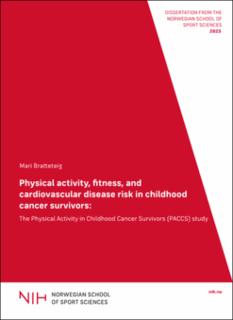| dc.contributor.author | Bratteteig, Mari | |
| dc.date.accessioned | 2023-11-09T11:39:14Z | |
| dc.date.available | 2023-11-09T11:39:14Z | |
| dc.date.issued | 2023 | |
| dc.identifier.isbn | 978-82-502-0614-4 | |
| dc.identifier.uri | https://hdl.handle.net/11250/3101616 | |
| dc.description | Avhandling (doktorgrad) - Norges idrettshøgskole, 2023 | en_US |
| dc.description.abstract | Background: Childhood cancer survivors face an increased risk of late effects from cancer treatment. Physical activity may modify the risk of common late effects, such as cardiovascular disease (CVD). Evidence concerning levels of physical activity in large samples of adolescent survivors based on robust measurement methods is lacking. Moreover, whether CVD risk factors are present already in adolescence and how physical activity and fitness are associated with CVD risk in this population is not well studied.
Aims: The main aims of this thesis were I) to describe levels of physical activity and sedentary time in young childhood cancer survivors and to compare levels of physical activity and sedentary time with age- and sex-stratified references, II-III) to compare CVD risk factors in young survivors with age- and sex-stratified references and controls and to examine the associations between physical activity and different domains of fitness with CVD risk factors in survivors and controls.
Design and participants: This thesis was based on cross-sectional data from work packages 1 and 2 of the international, multicenter Physical Activity in Childhood Cancer Survivors (PACCS) study. Participants aged 9-16 years with any previous cancer diagnosis who had completed cancer treatment ≥ 1 year ago were eligible to participate in the first work package. Participants from 9-18 years who were able to perform a cardiopulmonary exercise test were further invited to work package 2.
Methods: Single CVD risk factors were assessed based on cardiorespiratory fitness (Paper II only), adiposity (body mass index (BMI) or android fat mass), systolic blood pressure (SBP), ratio of total-cholesterol to HDL-cholesterol (Total/HDL), and glycosylated hemoglobin (HbA1c, Paper III only). Additionally, standardized scores (z-scores) of cardiorespiratory fitness, BMI, SBP, and Total/HDL were averaged to create a CVD risk score (Paper II). Physical activity and sedentary time were assessed by accelerometry, cardiorespiratory fitness by cardiopulmonary exercise test, and musculoskeletal fitness by maximal isometric strength tests.
Main results: I) Among young childhood cancer survivors (mean age 12.2 years), 34% were physically active for ≥ 60 minutes per day on average. Risk factors of lower physical activity and/or higher sedentary time were being female, older, overweight, a survivor of CNS tumor, and having experienced a relapse. In general, male survivors were less physically active compared to the references, whereas female survivors were similar to the references. Both male and female survivors spent more time sedentary than the references. II-III) Concerning CVD risk factors, male survivors had lower cardiorespiratory fitness compared to the references but similar BMI, SBP, and Total/HDL. Female survivors and the references had similar levels of all the CVD risk factors. Compared to the controls, survivors had higher levels of android fat mass and lower SBP, whereas Total/HDL and HbA1c were similar. Spending more time in all intensities of physical activity was associated with higher cardiorespiratory fitness, while more time in moderate and vigorous intensities were additionally associated with lower Total/HDL and a lower CVD risk score. More time in moderate-to-vigorous physical activity, higher cardiorespiratory, and higher musculoskeletal fitness were associated with lower levels of android fat mass and Total/HDL and higher SBP in survivors. Neither moderate-to-vigorous physical activity, cardiorespiratory fitness, nor musculoskeletal fitness were associated with HbA1c. The associations between cardiorespiratory and musculoskeletal fitness with android fat mass were stronger in survivors compared to the controls.
Conclusion: Overall, young childhood cancer survivors had unfavorable levels of physical activity, sedentary time, and some CVD risk factors. Among survivors, spending more time in higher intensities of physical activity, together with higher cardiorespiratory and musculoskeletal fitness, were associated with more favorable levels of CVD risk factors. As adolescence is a crucial period with respect to establishing lifestyle habits, we call for tailored interventions to increase physical activity and reduce sedentary time in young survivors and to examine the effect on CVD risk factors in longitudinal study designs. | en_US |
| dc.language.iso | eng | en_US |
| dc.relation.haspart | Paper I: Grydeland M*, Bratteteig M*, Rueegg CS, Lie HC, Thorsen L, Larsen EH, Brügmann-Pieper S, Torsvik IK, Götte M, Lähteenmäki PM, Kriemler S, Fridh MK, Anderssen SA, Ruud E. Device-measured physical activity in adolescent childhood cancer survivors: the PACCS study. [Manuscript revised and resubmitted to Pediatrics] | |
| dc.relation.haspart | Paper II: Bratteteig M, Anderssen SA, Rueegg CS, Ruud E, Torsvik IK, Kriemler S, Grydeland M (2022). Device-measured physical activity and cardiovascular disease risk in adolescent childhood cancer survivors. A physical activity in childhood cancer survivors (PACCS) study. Frontiers in Pediatrics. doi:10.3389/fped.2022.977365. | |
| dc.relation.haspart | Paper III: Bratteteig M, Rueegg CS, Raastad T, Grydeland T, Torsvik IK, Ruud E, Anderssen SA. Physical activity, fitness, and cardiovascular disease risk in adolescent
childhood cancer survivors compared to controls. The physical activity in childhood cancer survivors (PACCS) study. [Manuscript submitted to Journal of Adolescent and Young Adult Oncology] | |
| dc.subject | nih | |
| dc.subject | doktoravhandlinger | |
| dc.title | Physical activity, fitness, and cardiovascular disease risk in childhood cancer survivors: The Physical Activity in Childhood Cancer Survivors (PACCS) study | en_US |
| dc.type | Doctoral thesis | en_US |
| dc.description.version | publishedVersion | en_US |
| dc.description.localcode | Institutt for idrettsmedisinske fag / Department of Sports Medicine | en_US |
